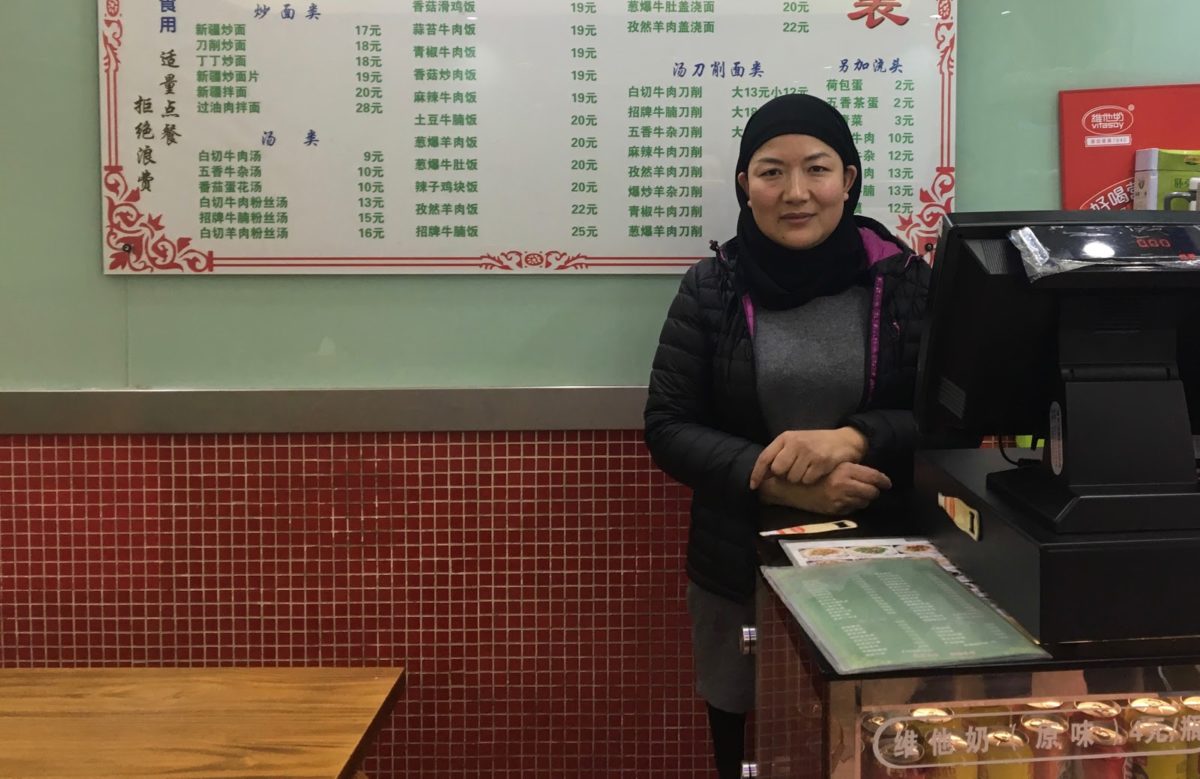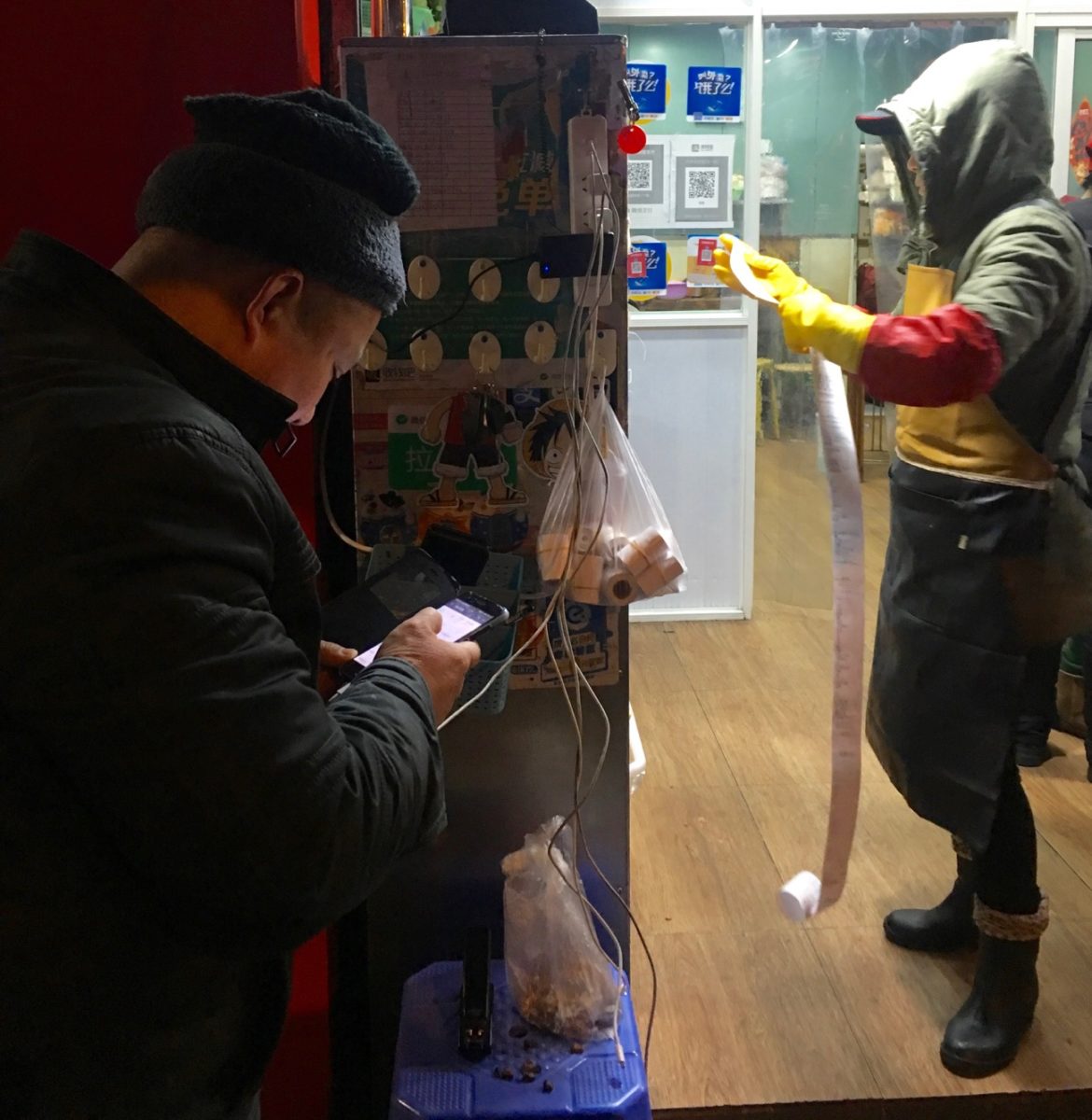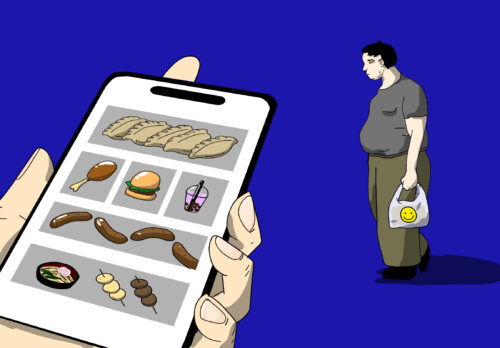Hole in the wall 2.0: How China’s food delivery industry is changing the restaurant business

Ever wonder why ordering takeout is so cheap in China? While Alibaba and Tencent jostle for dominance in the waimai market, small family-owned restaurants are feeling the pinch.

It’s nearing six o’clock on a Monday night in Shanghai and Mr. Wang is working fast, grabbing brown paper bags full of steaming bowls of soupy malatang 麻辣烫, scrutinizing and stapling their receipts, arranging them along the sidewalk. Periodically, he stands from his crouch to follow up on a chime or scroll through an order log on one of the three cell phones hanging at arm’s reach from his workstation at the front of Tianxiang Malatang 天香麻辣烫 restaurant.
Curbside, a gallery of heavily jacketed delivery drivers watch him, waiting for the moment an order is thrust forward, to be tucked into an oversized lunchbox carrier and rocketed into rush-hour traffic on the back of a scooter.
These drivers, ubiquitous in major cities, have revolutionized how China eats. Some 80 million monthly users are ordering 外卖 (wàimài) — delivery — using mobile apps, according to People’s Daily, with live GPS maps tracking the location of their meals. It’s an industry that has become another battlefront for Chinese tech giants Alibaba, Baidu, and Tencent, as their respective delivery app services — Ele.me (饿了么, founded 2008 in Shanghai), Baidu Waimai (百度外卖, 2011, Beijing; now owned by Ele.me), and Meituan Waimai (美团外卖, 2013, Beijing) — vie for dominance.
But the $32 billion online food delivery industry is also having a significant impact on the restaurant business itself, specifically the way that owners of the many family-owned and hole-in-the-wall eateries that line China’s urban streets are earning their livings. While their businesses may receive a much greater volume of orders through delivery platforms, restaurant workers and owners are finding themselves working harder for less profit per order. And as demand for delivery increases, opting out becomes increasingly impossible.
“If you don’t have it, you won’t survive,” says Wang about the delivery apps, barely looking up from his malatang assembly line. “Everything has moved online.”
Tianxiang Malatang ran for the better part of a decade before online delivery took hold. Catering to a rapidly expanded customer base has required adding more staff to shifts and adapting to new ergonomics, with many more plastic containers and order-processing cell phones. The restaurant receives 700 to 800 takeout orders each day, comprising 80 percent of its business. But they’re not making nearly as much as they would have hoped, says Wang, who is a relative of the owner from Anhui.
The reasons are simple. First, delivery apps take a hefty cut: between 18 and 20 percent out of each order in Shanghai. This rate appears to be similar to what delivery apps such as Seamless and GrubHub charge restaurant owners in the U.S. But on top of this, because there is such a proliferation of choice in China, customers are constantly bargain hunting, seeking restaurants that offer discounts and promotions. Some 1.3 million restaurants across 2,000 cities have already registered on Ele.me, while Meituan Dianping reports having 2 million partner businesses (Dianping is a restaurant rating platform similar to Yelp; it’s unclear exactly how many of those 2 million registered restaurants are also on the delivery platform Meituan Waimai). The result for restaurant owners is a lot more work for a proportionately small increase in revenue.

“The large corporations that get the high volume are the ones that benefit.”
From the middle of his congee restaurant, Mr. Yang, originally from Fujian, explains how his business model has shifted radically in recent years. Eight years ago he had a streetside restaurant with almost exclusively dine-in customers; now he’s in a secluded stall of a wet market, where rent is lower and upwards of 90 percent of orders are online.
He makes more money now, but the profit off each online order — he gets about 300 per every day — is significantly less. And Yang worries about sustainability as online competition gets steeper. He’s already seen a decline in profits from 2016 to 2017.
“With more shops coming online, there’s pressure to keep the prices low, but there’s also a service charge,” he explains, noting that he pays to appear higher in search results, an opaque process that involves forking over between 0.1 and 4 yuan (about 60 cents) for each customer click they receive. “I can’t charge the same as I’m charging in the shop, there would be zero profit.”
Zero profit is a reality of the larger industry as well. The food delivery market continues to expand, seeing 44 percent annual growth since 2013, but as of this summer, the major players were still running without a profit, according to the South China Morning Post. Instead, the growth of these businesses has been characterized by mergers and heavy investment from China’s tech leaders, enabling each to increase its market share. The online-to-offline services marketplace Meituan, whose food delivery service holds 43.5 percent market share, merged with its Tencent-backed competitor Dianping in 2015, while Alibaba Group Holding–backed Ele.me now holds 49.8 percent after acquiring Baidu Waimai last August. Alibaba is currently looking to consolidate its hold on Ele.me by buying out other investors within the company, according to a Bloomberg report this week. This kind of progression goes by the playbook for China’s tech start-ups, from bike sharing to ride-hailing: smaller competitors are muscled out or bought as the industry turns into a proxy battle between a few major corporations.
“Big players can afford to lower prices,” says Geoffrey Crothall, communications director of China Labour Bulletin, a Hong Kong-based labor watchdog. “They know with volume of deliveries, they can squeeze out the smaller competitors. This in turn puts more and more pressure on the food delivery workers, who have to deliver a higher volume, and on the restaurant owners, who have to turn out more product in a shorter period or time.
“So what do they do? Hire more staff and chefs, even though there’s no guarantee of additional revenue coming in. The large corporations that get the high volume are the ones that benefit.”
In multiple cities, from Kunming to Beijing, food delivery drivers have pushed back against falling wages and increasing company demands (which have led to dangerous driving and a rise in urban traffic accidents). In Shanghai, there is now a dedicated trade union for food delivery workers. Data collected by the union found that 90 percent of the city’s food deliveries were made by drivers who are subcontracted from labor agencies, not directly from Ele.me or Meituan Waimai, meaning those companies have no formal responsibilities for the drivers, according to China Labour Bulletin.
“In many ways [the industry] is undermining old systems and reconfiguring them online,” says Keegan Elmer, a labor specialist who focuses on China. “It’s done by shaking up labor relations to a company, and the same thing may happen with restaurants — they are shaking up these markets and reconfiguring them on their own terms, and often at the expense of the people who are working them.
“But on the consumer end, if you are sitting in your fancy apartment, things seem pretty good when you push the button.”
In the restaurant industry, where owners and workers are more decentralized than delivery drivers, and businesses are essentially competing against each other, labor experts say they have yet to see any signs that restaurants are organizating to promote their interests. Meanwhile, with two companies basically monopolizing the food delivery sphere, the apps are offering fewer deals, leaving the restaurants to offer more promotions and lower prices to attract customers.
“These online platforms will do nothing to actually help the individual businesses that they are facilitating in terms of generating more customers,” says Crothall of China Labour Bulletin. “It really does fall back on the individual restaurants to do advertising and marketing for their own product.”

Jockeying for business on the delivery platforms can feel like a race to the bottom, according to Ma Fang 马芳, who has run a popular pulled noodle and lamb skewer joint for the past 16 years. Ma started listing her menu on the delivery apps a couple of years back at the suggestion of her sister, who also runs a Shanghai noodle shop.
“After my sister started working with Ele.me, she got 200 to 300 orders per day,” Ma says. “But it was at a steep discount — charging 50 RMB ($8) for walk-in customers, but 12 RMB ($2) for those on Ele.me. The orders piled up in the beginning, but stopped when she stopped the discounts.”
For Ma, who never uses discounts and has restricted her online menu to items that transport well, online business has hovered around 20 to 30 order per day. It’s not uncommon to see customers lined up outside her shop, waiting for lamb skewers from the outdoor oven. With a healthy walk-in business, the Gansu native says she feels less urgency in cranking online delivery orders to make profits.
“When people go on Ele.me they care more about the prices, they want cheaper stuff, convenience — but people come to my place to eat,” she says. “They don’t care much about the price, they just love our food.”
As for whether the delivery apps are a boon or a burden for business, restaurant owners have mixed feelings. Though Ma’s business is mostly eat-in, she views it as a necessary service for her regular customers, but one she grudging accepts — “The only convenient point for me is that I don’t have to hire my own guy for delivery,” she says. Even Yang, whose congee restaurant is carried by the delivery trend, has his reservations: “It’s some good and some bad,” he says.
With the industry projected to expand to more cities and reach heights of $35 billion next year, it’s poised to continue to change the face and fate of these businesses — for better or for worse.







